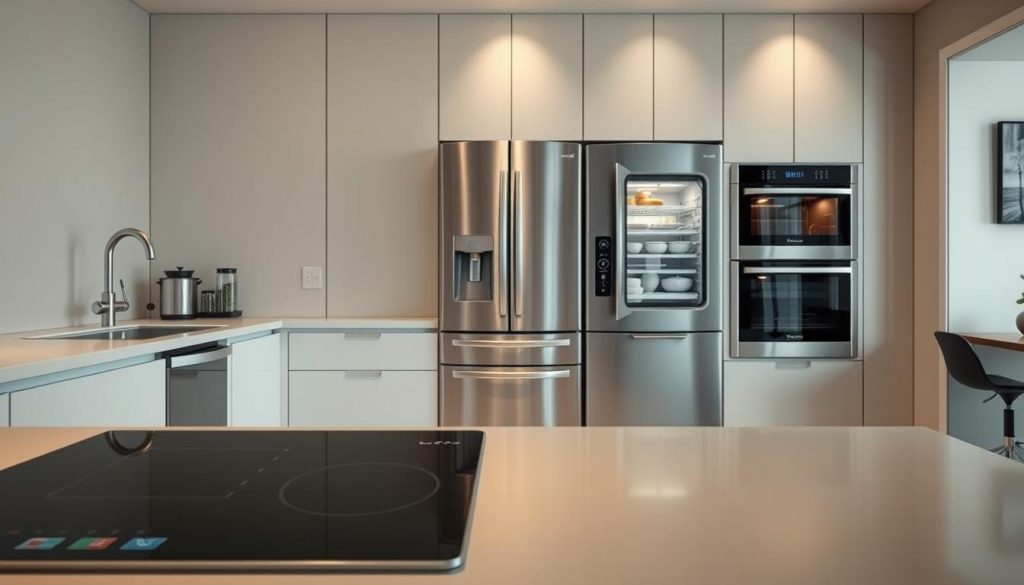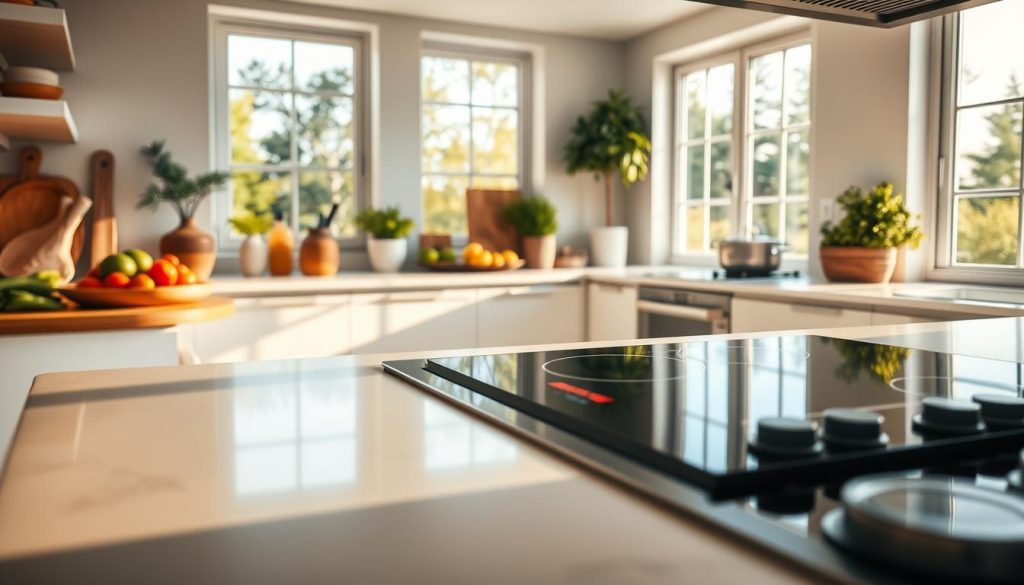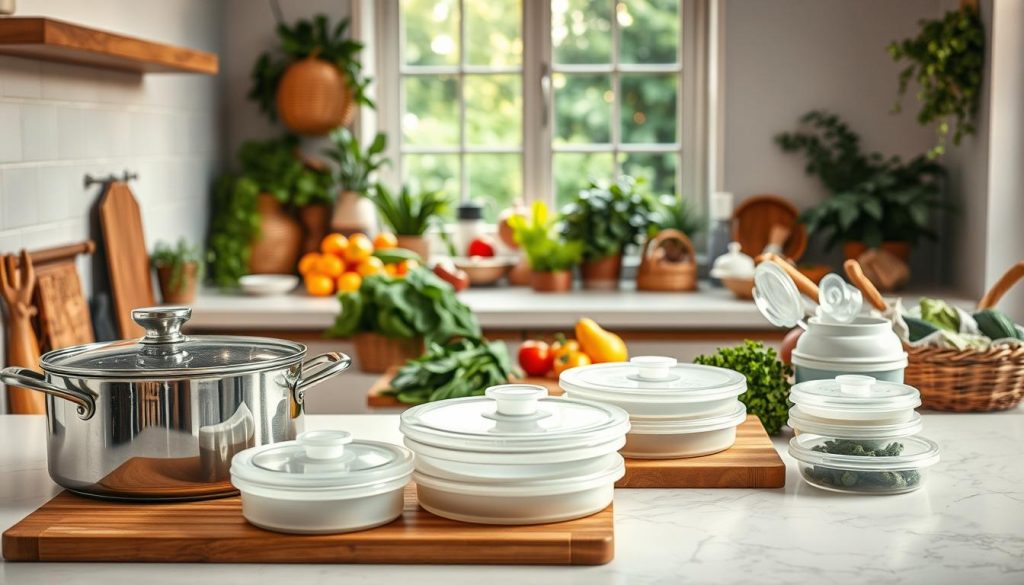Your Guide to Energy-Efficient Cooking & Water-Saving in 2025
Full Guide to Energy-Efficient Cooking and Water-Saving For 2025
Make your kitchen a green space with energy-efficient cooking and water-saving techniques 2025. This guide shows how sustainable kitchen practices can save money, help the planet, and make life easier. Every choice in your kitchen helps create a greener future.

Key Takeaways
- Modern energy-efficient cooking tools can cut utility bills by up to 30% compared to old methods.
- Water-saving techniques 2025 include new ideas like greywater systems and sensor faucets.
- Old recipes can still be made with sustainable kitchen practices without losing flavor.
- Smart tech like AI ovens and induction stoves use less heat while keeping meals tasty.
- Updating your kitchen to 2025 standards can increase your home’s value and save money in the long run.
The Kitchen Revolution: Why Sustainable Practices Matter More Than Ever
habits isn’t just a trend—it’s a necessity.
The Environmental Impact of Traditional Cooking Methods
Traditional ovens, gas ranges, and old dishwashing ways waste a lot. They use a lot of resources. A study found that homes using these methods produce 1,200 kg of CO₂ annually, which is like driving 2,700 miles. Also, a single faucet drip can waste 3,000 gallons of water every year.
| Method | Traditional | Sustainable |
|---|---|---|
| Energy Use | Gas stoves: 15% higher emissions | Induction: 50% faster, 50% less energy |
| Water Use | Handwashing dishes: 20 gallons/session | Energy Star dishwashers: 3 gallons/session |
Rising Utility Costs and the Financial Case for Efficiency
- Electricity bills for average U.S. homes rose 8% in 2024
- Induction cooktop users save $200+ annually vs. electric coils
- Low-flow faucets cut water costs by 30%
Meeting America’s Climate Goals Through Household Changes
If every U.S. home used 10% less energy for cooking, it would cut 12 million tons of CO₂ yearly. This is like planting 250 million trees. The Biden Administration wants to cut 40% of household emissions by 2030. Making small changes in reducing carbon footprint in the kitchen can help achieve big goals.
Energy-Efficient Cooking and Water-Saving Techniques 2025: What’s New
Kitchens are changing in a big way. New energy-efficient cooking and water-saving techniques 2025 are making it easier to be green. Smart sensors and new materials are leading the charge in kitchen sustainability trends.
- AI-driven recipe optimization: Apps now analyze your meals to suggest energy-saving prep methods.
- Thermal-retention cookware: Pots retain heat longer, reducing stove time by up to 30%.
- Smart faucet systems
- Greywater recycling kits: Reuse dishwater for gardening without complex installations.
Big names like Bosch and KitchenAid are adding solar panels to countertops. A 2024 USDA study showed these panels cut energy use by 25% for most homes. Even small changes, like using pressure cookers, can save a lot of power and water.
“The next wave of kitchen tech isn’t just about gadgets—it’s about rethinking every step of cooking,” says Dr. Lena Torres, MIT Energy Lab.
These new features are not only good for the planet. They also make cooking easier. Look for stovetops that show how much energy you’re using, or dishwashers that adjust based on how dirty your dishes are. Each upgrade brings you closer to a kitchen that’s both efficient and easy to use.
Smart Appliances Transforming Kitchen Sustainability
Modern energy-saving appliances are changing kitchens. They include AI ovens and water-smart dishwashers. These make sustainable kitchen practices simple. Learn how tech can save money and the planet without losing performance.
AI-Powered Cooking Systems That Minimize Energy Use
Brands like Thermomix and Samsung have AI ovens. They learn your cooking habits. This means they use less energy, up to 40% less.
- Predictive algorithms adjust power use based on recipe complexity
- Self-diagnostic sensors prevent overheating
- Compatibility with smart home systems for centralized energy management
Next-Generation Induction Technology
Induction ranges from Breville and Cooktek heat pans 50% faster than gas stoves. They control temperature precisely, saving energy. Switching from electric coils can cut energy use by 30%.
Water-Recycling Dishwashers and Their Impact
Bosch’s AquaStop and LG’s TurboWash models save up to 60% of wash water. They filter and reuse water, reducing household water use. Using them with low-flow faucets makes kitchens more sustainable.
These smart appliances show that saving energy doesn’t mean giving up convenience. Look for models with ENERGY STAR ratings for verified efficiency.
Mastering Low-Energy Cooking Methods for Everyday Meals
Small changes in your kitchen can save energy and taste. Start with these eco-friendly cooking tips to make your meals greener. They save energy and time.
- Use lids to trap heat: A covered pot reduces cooking time by 30% for soups and stews.
- Cook in batches: Prepare large portions once a week, then reheat efficiently.
- Match pot size to your stove: Small burners with small pots prevent wasted heat.
- Leverage residual heat: Turn off the oven 10 minutes early—food finishes cooking using stored heat.
- Pressure cook grains and beans: Saves 70% energy vs. stovetop boiling.
- Slow cook overnight: Low-power settings retain nutrients while using minimal energy.

Try new ways with classics like chili or roasted veggies. Use insulated cookware for better results. For example, browning meat in a cast-iron skillet then transferring to a slow cooker cuts energy use by 40%.
Meal planning tools like apps or calendars help you plan with energy-efficient techniques. Every small change, like steaming veggies with a bamboo steamer or baking multiple dishes at once, makes your kitchen more sustainable and tasty.
Water Conservation Strategies for Modern American Kitchens
Adopting water-efficient kitchen habits is key to sustainable living through cooking practices. Simple adjustments can cut water use without sacrificing convenience. Start by exploring these proven methods tailored for 2025 kitchens.
Greywater Systems for Kitchen Integration
Repurpose used cooking water with greywater systems. These systems filter rinse water from vegetables or pasta for toilet flushing or gardening. Consider these options:
- Countertop filtration kits (e.g., Aqus Greywater Systems) for DIY setups
- Whole-house systems for high-volume kitchens
| Type | Water Saved | Setup Cost |
|---|---|---|
| Basic Kit | Up to 30% per month | $200–$500 |
| Full System | 50%+ annual savings | $1,500–$3,000 |
Sensor-Based Faucets and Flow Regulators
Modern faucets like Delta’s Touch2O® technology shut off automatically when not needed. Pair these with flow regulators rated at 1.5 gallons per minute to slash usage. Benefits include:
- Up to 40% reduction in daily water use
- Compatibility with ENERGY STAR® certified appliances
Drought-Resistant Cooking Techniques
Try these methods to minimize water waste:
- Steam vegetables in minimal water using a bamboo steamer
- Reuse pasta water to hydrate grains (e.g., rice cooked in broth)
- Adopt sous vide cooking to retain moisture naturally
These strategies turn your kitchen into a model of efficiency. Start small—every drop saved contributes to broader sustainability goals.
The Financial Benefits: Calculating Your Savings from Eco-Friendly Cooking
Choosing energy-efficient cooking and water-saving techniques 2025 is smart for your wallet and the planet. Let’s look at how sustainable kitchen practices lead to savings. First, track your current utility bills. Then, use tools like the U.S. Department of Energy’s Energy Saver calculator to estimate savings.

- Appliance efficiency ratings (look for ENERGY STAR®-certified models)
- Regional utility rates (varies from $0.12/kWh in Texas to $0.22/kWh in California)
- Meal prep habits (batch cooking reduces per-meal energy use)
For instance, switching to a GE Profile Smart Induction Cooktop can save 50% on energy. This means saving up to $300 a year. Water-saving dishwashers, like Bosch’s 800 Series, can pay for themselves in 2-3 years with rebates.
Don’t forget about federal tax credits (up to $1,000 for qualified equipment) and state programs like California’s Cash for Appliances rebate. These can increase your savings even more.
“Households adopting these methods see 20-30% utility bill reductions within 12 months.” — U.S. Environmental Protection Agency, 2024
Use online calculators from brands like Whirlpool or your local utility provider. Input your usage patterns and consider rebates from programs like DSIRE. Every dollar saved today helps your budget and the environment.
Seasonal Approaches to Kitchen Efficiency Throughout the Year
Changing your kitchen habits with the seasons saves energy and water. These eco-friendly tips help your green cooking efforts all year. Let’s see how to adjust for each season’s needs.
Summer Cooking Strategies to Keep Your Kitchen Cool
Shifting cooking methods helps avoid overheating. Try outdoor grills or solar ovens to cut AC use. Choose no-cook meals like salads or chilled soups.
Run appliances like dishwashers at night. This cuts energy costs and indoor heat. It’s a smart move.
Winter Efficiency: Using Heat Wisely
Make oven heat work for you. Bake on cold days and open oven doors to warm your home. Slow cookers and pressure cookers save energy by keeping heat in.
Batch-cook meals to use the stove less. This saves energy and time.
Adapting Water Usage by Season
In dry seasons, collect rainwater for your garden or greywater systems. Install low-flow faucets like Delta’s HydraKinetic models. They reduce water waste.
Adjust your dishwashing routine. Air-dry dishes in summer and use shorter cycles in winter. It’s a water-saving tip.
Zero-Waste Cooking: The Perfect Companion to Energy Efficiency

Every bite of food you save helps the planet. Zero-waste cooking cuts down on trash and energy. Start by using every part of a vegetable, like carrot tops in pesto or broccoli stems in stir-fries.
This approach reduces kitchen waste and saves energy. It’s a big step toward a greener kitchen.
- Freeze vegetable scraps for homemade broth, avoiding single-use broth cubes.
- Store herbs in water-filled mason jars to extend freshness without refrigeration.
- Use compostable containers for leftovers instead of disposable wraps.
| Traditional Habit | Zero-Waste Upgrade |
|---|---|
| Throwing stale bread | Toast into crumbs for breading or croutons |
| Discarding citrus peels | Zest for baking or infuse oils |
Less food waste means less energy used in food production. Keep track of what you have in your pantry to avoid waste. For example, use overripe bananas for bread and wilted veggies in soups.
Every saved ingredient saves energy and resources. This is a big step toward a greener kitchen.
“The most sustainable kitchens are those that value every resource.” – Chef Alice Waters, zero-waste advocate
Adding energy-efficient appliances to your kitchen can make a big difference. Small changes like using every part of a vegetable or planning meals better can make your kitchen more sustainable. Every step you take toward zero-waste cooking makes your kitchen greener.
Retrofitting Your Existing Kitchen for 2025 Standards
Updating your kitchen doesn’t mean a complete redo. Small, focused changes can make your space more energy-saving and kitchen sustainability trends friendly. Start with affordable upgrades that pack a big punch.
Budget-Friendly Upgrades for Maximum Impact
Here are some easy, budget-friendly steps:
| Upgrade | Cost Range | Impact |
|---|---|---|
| Smart power strips | $20–$50 | Cuts standby energy use by 15% |
| Faucet aerators | $10–$25 | Cuts water use by 50% without sacrificing flow |
| Door seals for refrigerators | $10–$15 | Improves cooling efficiency by 10–20% |
Add energy-efficient LED under-cabinet lighting, like Philips Hue, to save even more.
Professional Assessment Options for Energy Audits
For deeper insights, consider hiring certified auditors like Energy Star Partners. A typical audit costs $200–$500 and includes:
- Thermal scans to detect insulation gaps
- Appliance efficiency ratings
- Customized retrofitting recommendations
“Even small leaks or outdated wiring can waste 20% of energy use,” says the U.S. Department of Energy.
Combine DIY efforts with expert advice to meet kitchen sustainability trends. Start small, scale smartly, and use free tools like the Energy.gov calculator. Every choice brings you closer to a 2025-compliant kitchen without spending a lot.
Overcoming Challenges: When Conservation Meets Culinary Tradition
Making traditional dishes more sustainable doesn’t mean losing their soul. Green cooking methods can keep family recipes alive while using fewer resources. Start by tweaking cooking times or tools. For instance, switch a slow-cooked stew to a pressure cooker to save up to 40% on energy.
Small changes can keep heritage alive without sacrificing tradition.
Adapting Family Recipes for Energy Efficiency
Rethink how you prepare classics:
- Use induction cooktop zones to heat smaller portions faster.
- Replace long simmering with steam cooking for vegetables and grains.
- Freeze prepped ingredients to reduce prep time and energy waste.
Balancing Special Occasions with Sustainable Practices
Holidays don’t have to mean excess. Environmentally conscious cooking can shine during celebrations. Try:
- Plan menus around one-pot meals to cut down appliance use.
- Use leftovers creatively to minimize food waste.
- Opt for energy-star appliances when roasting or baking in bulk.
| Traditional Method | Sustainable Update |
|---|---|
| Boiling pasta uncovered | Lid-on simmering to reduce gas use |
| Preheating ovens for 30+ minutes | Modern ovens with rapid preheat features |
“Sustainability isn’t about rejecting tradition—it’s about reimagining it.” — James Beard Foundation, 2024
Community Initiatives: Joining Forces for Greater Impact
Working together on sustainable living through cooking practices can make a bigger difference. When communities share resources, they achieve more than individuals can alone. This teamwork brings environmental and financial gains.
- Tool libraries let neighbors borrow specialty appliances, reducing redundant purchases and energy use.
- Shared solar kitchens powered by projects like SunPower Collective cut home energy bills while lowering emissions.
- Co-op buying groups negotiate discounts on energy-efficient stoves and dishwashers, making kitchen sustainability trends accessible to more households.
“Pooling resources lets us invest in better equipment while saving time and money,” says a participant in Portland’s Kitchen Collective, a program slashing appliance energy use by 40% through shared ownership.
Start local by:
- Hosting neighborhood workshops to share energy-saving recipes and techniques
- Partnering with schools to map energy use in community kitchens
- Joining CSA programs like FarmLink that prioritize low-impact food transport
Community composting hubs, like Chicago’s Green Bin Network, turn food scraps into fertilizer while reducing landfill waste. These efforts create ripple effects—lower utility costs, stronger neighborhood ties, and measurable environmental progress. Explore platforms like Neighbor.ly to find or launch similar programs in your area. Collective action turns everyday cooking into a force for change.
The Unexpected Benefits: How Efficient Cooking Enhances Food Quality
Believe it or not, using eco-friendly cooking tips and water-efficient kitchen habits can make your food taste better. Cooking with precision lets you control the heat perfectly. This way, you can keep flavors in and avoid overcooking.
Water-smart methods like steaming vegetables instead of boiling help keep vitamins. These vitamins would otherwise go into the water.
- Slow cooking at lower temps breaks down flavors in stews, creating richer tastes.
- Water-efficient steaming keeps nutrients like vitamin C in broccoli, not down the drain.
- Induction cooking’s quick heat stops meats from drying out, improving texture.
“My sous vide setup not only saves energy but gives meats a consistency I couldn’t achieve with gas stoves,” says chef Jamie Oliver, who cut energy use 30% without sacrificing his Michelin-starred dishes.
Many think efficiency means giving up quality, but science proves otherwise. Slow, precise cooking methods help keep nutrients in food. For instance, boiling pasta in less water makes it firmer.
Even simple tricks like blanching veggies in half the usual water boost flavor. Start with small changes. Try steaming fish instead of boiling it, or use pressure cookers that tenderize meats with 70% less energy. Every adjustment makes sustainability a key to better tasting, healthier meals.
Conclusion: Your Path to a Sustainable Kitchen Future
Every choice in your kitchen affects the planet. Choosing sustainable kitchen practices in 2025 is more than a trend. It’s a way to cut down on waste and save money. Start with small steps like using Energy Star appliances or induction cooktops.
These changes reduce energy and water use right away. Use tools like the EPA’s carbon calculator to track your progress. You can also see your savings by checking your energy and water bills.
Focus on the biggest impacts first, like replacing old dishwashers. Or, try budget-friendly options like sensor faucets. Even small changes, like cooking for less time or using greywater for plants, help a lot.
It’s important to scale up your efforts. Join local recycling programs or energy-saving campaigns. Brands like Whirlpool and Bosch have guides to help you upgrade your kitchen without breaking the bank. Share your ideas with neighbors to make a bigger difference.
By 2025, kitchens can be at the forefront of innovation. Whether it’s new appliances, better water use, or seasonal menus, every action matters. Your choices today will help create a future where kitchens are both efficient and eco-friendly. Start now, and watch your kitchen transform with one mindful step.



